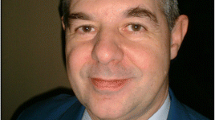Abstract
Analysis of three-dimensional (3D) images of human torsos for torso deformities such as scoliosis requires classifying torso distortion. Assessing torso distortion from 3D images is not trivial as actual torsos are non-symmetric and show an outstanding range of variations leading to high classification errors. As the degree of spinal deformity (and classification of torso shape) influences scoliosis treatment options, the development of more accurate classification procedures is desirable. This paper presents a technique for assessing torso shape and classifying scoliosis into mild, moderate and severe categories using two indices, ‘twist’ and ‘bend’, obtained from orthogonally transformed images of the complete torso surface called orthogonal maps. Four transforms (axial line, unfolded cylinder, enclosing cylinder and subtracting cylinder) were used. Blind tests on 361 computer models with known deformation parameter values show 100% classification accuracy. Tests on eight volunteers without scoliosis validated the system and tests on 22 torso images of volunteers with scoliosis showed up to 95.5% classification accuracy. In addition to classifying scoliosis, orthogonal maps present the entire torso in one view and are viable for use in scoliosis clinics for monitoring the progression of scoliosis.






Similar content being viewed by others
Notes
Other classifications systems such as that by Lenke et al. [14] are also used.
INSPECK Inc., Montreal, QC, Canada
KONICA-MINOLTA Photo Imaging Inc., Mahwah, NJ, USA
The maximal diameter of a closed 2D shape such as a torso cross-section is the longest distance between any two points in the convex hull of the shape.
The orthogonal maps of a perfect circular cylinder are devoid of contours.
As twist and bend indices are basis vectors in deformity space, the classification was based on their norm.
Their torso scans were used to check the null-response pattern of the system.
References
Ajemba PO, Kumar A, Durdle NG, Raso VJ (2006a) Quantifying torso deformity in scoliosis. In: Proceedings of the SPIE, vol 6144, p 614450
Ajemba PO, Durdle NG, Hill D, Raso VJ (2006b) Posture and re-positioning considerations of a complete torso topographic analysis system for assessing scoliosis. In: Proceedings of the SPIE, vol 6056, 60560O
Ajemba PO, Durdle NG, Hill D, Raso VJ (2006c) A torso imaging system for quantifying the deformity associated with scoliosis. IEEE Trans Instrum Meas (to appear)
Ajemba PO, Durdle NG, Hill D, Raso VJ (2005) A torso imaging system for quantifying the deformity associated with scoliosis. In: Proceedings of the IEEE instrumentation and measurement technology conference, Ottawa, 17–19 May
Berg DC, Hill DL, Raso VJ, Lou E et al (2002) Using three-dimensional difference maps to assess changes in scoliotic deformities. Med Biol Eng Comput 40:290–295
Cobb JR (1948) Outline for the study of scoliosis, instructional course lectures. Am Acad Orthop Surg 5:261–275
Dickson RA (1999) Spinal deformity—adolescent idiopathic scoliosis: nonoperative treatment. Spine 24(24):2601–2606
Drerup B, Hierholzer E (1996) Assessment of scoliotic deformity from back shape asymmetry using an improved mathematical model. J Biomech 11(7):376–383
Golberg CJ, Kaliszer M, Moore DP, Fogarty EE, Dowling FE (2001) Surface topography, Cobb angles and cosmetic change in scoliosis. Spine 26:E55–E63
Hierholzer E, Frobin W (1981) Rasterstereography measurement and curvature analysis of the body surface of patients with spinal deformities. In: Moreland MS, Pope MH, Armstrong GWD (eds) Moire´ fringe topography and spinal deformity. Pergamon Press, New York, pp 267–276
Hill DL, Berg DC, Raso VJ, Lou E et al (2002) Evaluation of a laser scanner for surface topography. In: Tanguy A, Peuchot B (eds) Research into spinal deformities 3. IOS Press, Oxford, pp 90–95
Iwahara T, Imai M, Atsuta Y (1998) Quantification of cosmesis for patients affected by adolescent idiopathic scoliosis. Eur Spine J 7:12–15
Jaremko JL, Poncet P, Ronsky J, Herder J, Dansereau J, Labelle H, Zernicke RF (2002) Indices of torso asymmetry related to spinal deformity in scoliosis. Clin Biomech 17:559–568
Lenke LG, Betz RB, Harms J et al (2001) Adolescent idiopathic scoliosis: a new classification to determine extent of spinal arthrodesis J Bone Joint Surg 83-A(8):1169–1180
Levy AR, Goldberg MS, Mayo NE, Hanley JA, Poitras B (1996) Reducing the lifetime risk of cancer from spinal radiographs among people with adolescent idiopathic scoliosis. Spine 21:1540–1548
Liu XC, Thometz JG, Lyon RM, Klein J (2001) Functional classification of patients with idiopathic scoliosis assessed by the Quantec system. Spine 26(11):1274–1279
Moreland MS, Pope MH, Wilder DG et al (1981) Moire fringe topography of the human body. Med Instrum 15:129–132
Pazos V, Cheriet F, Song L, Labelle H, Dansereau J (2005) Accuracy assessment of human trunk surface 3D reconstructions from an optical digitising system. Med Biol Eng Comput 43:11–15
Raso VJ, Lou E, Hill DL, Mahood JK, Moreau MJ, Durdle NG (1998) Trunk distortion in adolescent idiopathic scoliosis. J Ped Ortho 18(3):22–26
Stokes IAF, Moreland MS (1989) Concordance of back surface asymmetry and spine shape in idiopathic scoliosis. Spine 14:73–78
Suzuki N, Inami K, Ono T, Kohno K, Asher MA (1999) Analysis of posterior trunk symmetry index (POTSI) in scoliosis: Part 1. In Research into Spinal Deformities 2:81–84
Theologis TN, Jefferson RJ, Simpson AH, Turner-Smith AR, Fairbank JCT (1995) Quantifying the cosmetic defect of adolescent idiopathic scoliosis. Spine 18:909–912
Turner-Smith AR, Harris JD, Hougton GR, Jefferson RJ (1988) A method of analysis of back shape in scoliosis. J Biomech 21:497–509
Acknowledgments
The authors will like to thank Dr. Marc Moreau and Dr. James Mahood for their help in obtaining the full torso scans of scoliosis patients. P. O. Ajemba was supported by the Province of Alberta Informatics Centre for Research Excellence (iCORE), the Bone and Joint Health Training Program of the Canadian Institute for Health Research (CIHR) and the Alberta Ingenuity Scholarship.
Author information
Authors and Affiliations
Corresponding author
Rights and permissions
About this article
Cite this article
Ajemba, P., Durdle, N., Hill, D. et al. Classifying torso deformity in scoliosis using orthogonal maps of the torso. Med Bio Eng Comput 45, 575–584 (2007). https://doi.org/10.1007/s11517-007-0192-z
Received:
Accepted:
Published:
Issue Date:
DOI: https://doi.org/10.1007/s11517-007-0192-z




